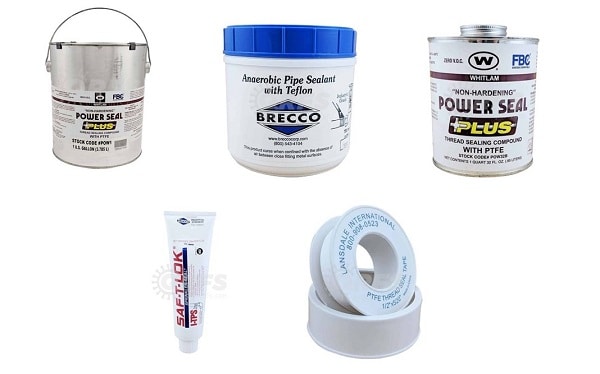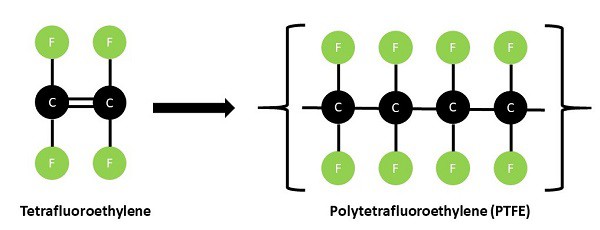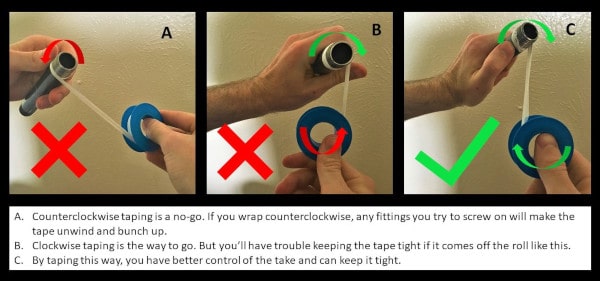Can You Use Teflon Tape And Thread Sealant Together
Learn about the convenience and purpose of pipage thread sealant
Threaded pipe saves fitters from labor- and skill-intensive piping-joining techniques like flanging, butt-welding, brazing, and soldering. Even so, different these other pipage fittings, threaded pipage connections don't form fluid-tight seals on their own. Specially nether pressure level, the threads leave space for fluids to leak out. That's where pipe thread sealants come up in.
Pipe dope, pipe joint compound, piping thread seal—these are all different names for products used to create fluid-tight seals in threaded pipe joints. Pipage thread sealants:
- Make full the gaps in threads, preventing fluid from leaking out
- Lubricate threads and so they spiral in smoothly
- Are chemically stable, non breaking downwards at temperature extremes or dissolving in common solvents
In this article, we answer mutual questions virtually piping thread sealants, including the departure betwixt paste and tape sealants, whether thread sealant is the same as PVC mucilage (it isn't!), and the deviation betwixt PTFE and Teflon™ (at that place isn't one). And then, nosotros show you how to employ pipe thread sealant to create h2o-tight joints in threaded pipage.

What is pipe thread sealant? Answers to common questions
Before we become into how piping thread sealant is used, let's dig into some common questions about information technology. Namely, we'll reply:
- What is thread sealant?
- What is PTFE?
- Is thread sealant glue?
- What's the difference between PTFE and Teflon™?
What is thread sealant?
Simply put, thread sealant is a material that fills the gaps at threaded pipe connections, preventing fluids from leaking out. As well creating fluid-tight seals, pipe thread sealants also lubricate the threads, making assembly quicker.
Pipe thread sealants come in two general varieties—paste and tape. Paste sealants are applied with a castor or finger directly to both the male and female threads. They are sometimes referred to every bit pipe dope or pipage joint compound. Paste sealants can take different ingredients. Some use PTFE. Others consist of a mixture of minerals, rosin, and alcohols.
Some pipe thread sealants are anaerobic, meaning they dry but in the absence of air and in the presence of metal. Other sealants aren't meant to dry at all. Read the product instructions to make sure you employ the right sealant for the right awarding.
Tape thread sealants are a mess-gratis alternative to paste sealants. Tape sealants take no solvent; instead, the sealant is made into a flick and is sold in rolls of varying width, thickness, and density. Record sealants are applied simply by wrapping the tape around and pressing it into the threads, and they are made of PTFE.
What is PTFE?
Lots of thread sealants are made of PTFE, merely what is it? Polytetrafluoroethylene (PTFE for short) is a fluoropolymer—in other words, a plastic that contains fluorine atoms. Its useful properties include:
- A melting point of effectually 620°F (327°C)—for most applications, PTFE won't melt
- Hydrophobic—it doesn't dissolve in h2o or get wet
- Chemically inert—PTFE won't dissolve or interruption downward in common organic solvents like acetone, turpentine, hexanes, or lighter fluid
- Low friction—PTFE is slippery, and then it's usually used to foreclose sticking
As well the threads of pipes, PTFE also unremarkably coats the surface of nonstick pans. The same backdrop that make information technology keen for sealing and lubricating pipe threads make it good for stick-free cooking.

Is thread sealant glue?
No! Despite the word "tape" and the demand for some sealants to dry or cure, pipe thread sealants are not adhesive. Think, the advantage of threaded piping is easy assembly and disassembly. Pipe thread sealant has a dual purpose. It seals the threads, but it also lubricates. Information technology makes them like shooting fish in a barrel to put together and take apart.
Pipage glue and piping thread sealant are basically opposites. Pipage glue is used to brand "slip" PVC joints permanent. PVC glue actually somewhat "melts" the male and female pipe so they fuse. If you put it on threaded PVC, yous destroy the threads.
What's the departure between PTFE and Teflon™? Which is ameliorate?
PTFE was first discovered past Roy J Punkett in 1938 while he was studying halocarbons in search of a new refrigerant for DuPont. Teflon™ is the trademarked named for PTFE. It and PTFE are the same chemical under dissimilar names. In that location is petty more reason to buy sealant labeled "Teflon" instead of sealant labeled "PTFE" than there is to buy name-make medication instead of the generic variety.
How to utilise pipe thread sealant
Applying thread sealant is like shooting fish in a barrel, but in that location are all the same right and wrong (and ameliorate and worse) ways to practice information technology. Whether y'all're using paste or tape, there are 2 general guidelines:
- Fill the threads
- Don't go thread sealant inside the pipe
At present, let'south get down to information technology. Here'southward how to apply PTFE record and pipe dope.
How to apply PTFE tape
Apply PTFE record to male threads merely. Follow these steps:
- Clean the male and female threads of dirt and oil
- Press a bit of tape against the last thread
- Wrap the tape clockwise around the threads, keeping it tight
- Employ iii-5 wraps (unlike tradesmen are going to fence almost how many)
- Tear the record off and press it into the threads
- Screw the threads into the plumbing fixtures. Always follow manufacturer instructions for tightening threaded piping fittings.
Seeing is better than doing. This video explains how to utilize PTFE tape without looking like a fool (or an apprentice):
In case you missed information technology, hither's a close-up of the correct and wrong ways to wrap PTFE tape:

PTFE tape is sufficient on its own. Simply some people swear by using PTFE record and pipe dope. The idea is that the pocket-size amount of time and money spent on double-sealing saves repair work afterwards. Other tradesmen insist that you should never combine paste and tape. Either manner, here's how to use pipe dope.
How to utilize pipage dope
Applying pipe dope is easy. The important affair is to fill upward the threads. A brush is good to have, merely a finger works just as well. Follow these unproblematic steps:
- Clean the male person and female threads of dirt and oil
- Mix the pipe dope thoroughly to ensure that the paste and solvent are combined
- Use a brush or your finger to coat the male threads only. Make full the threads, simply avoid getting paste inside the pipage
- Screw the male threads into the plumbing equipment. Some paste will ooze out; this is normal. Always follow manufacturer instructions for tightening threaded piping fittings
Once again, it's meliorate to meet it done. This video demonstrates the application of pipage dope:
As you tin can see, if you choose to use both pipage dope and PTFE tape, the tape goes on kickoff. Utilise the paste to the tape. If you're putting dope over the tape, pigment clockwise to avoid unraveling the tape. Retrieve, some pipage dope has to dry and requires contact with metal to do so. This means that information technology tin can't be used with tape.
When using pipe dope or PTFE record with plastic pipes, be careful not to overtighten. The lubrication provided by pipage thread sealant makes it easier to tighten as well much and crack the fitting.
Pipe thread sealant stops leaks, lubricates threads
Whether you employ pipe dope or PTFE tape, pipe thread sealant is essential for any threaded pipe application. Thread sealant serves two purposes: it creates a liquid-tight seal past filling gaps in threads and information technology makes assembly and disassembly easier past lubricating the threads. Pipe thread sealant is not gum or adhesive—in fact, it'southward the contrary.
PTFE, the generic proper noun for Teflon™, is a mutual textile for pipe thread sealants because it is chemically unreactive, slippery, and stable at farthermost temperatures. PTFE sealants tin can take the course of convenient tapes every bit well as pastes (sometimes chosen piping dope). Pipe dope can exist fabricated of substances other than PTFE, also.
Outfit yourself for your next project. Shop PTFE thread-seal tape and PTFE pipage sealant compound on our website—perfect for fire sprinkler pipe installation. We also have commercial and residential fire sprinkler heads and sprinkler wrenches and other tools yous need.
If y'all have questions or demand assist placing an guild, call us at +ane (888) 361-6662 or electronic mail [email protected].
This blog was originally posted at blog.qrfs.com . If this article helped you, check us out at Facebook.com/QuickResponseFireSupply or on Twitter @QuickResponseFS .
Can You Use Teflon Tape And Thread Sealant Together,
Source: https://blog.qrfs.com/362-how-to-use-pipe-thread-sealant/
Posted by: samonsatrom1955.blogspot.com


0 Response to "Can You Use Teflon Tape And Thread Sealant Together"
Post a Comment